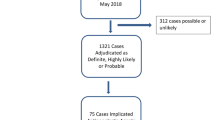Abstract
L-asparaginase is an effective antileukaemic drug and a potent inhibitor of hepatic protein synthesis. Its effect on lipid metabolism was studied in two cohorts of children with ALL, one of whom received L-asparaginase concomitantly with three other drugs (protocol BFM 79). In the second protocol (BFM 83) administration of L-asparaginase was arranged to follow the other three drugs in time sequence. The two major findings of this study were elevated serum levels of total cholesterol and a strong increase in serum triglycerides. The former change was due to an increase in α-cholesterol and could not be attributed to L-asparaginase because it was also found following protocol BFM 83 before the administration of the drug. Elevations of total triglycerides were due to high levels of exogenous chylomicron bound triglycerides and were limited in occurrence almost exclusively to the period of L-asparaginase monotherapy. Hypothyroidism was excluded as a possible pathogenetic mechanism. These changes in lipid metabolism induced by L-asparaginase during intensive remission induction chemotherapy are fully reversible.
Similar content being viewed by others
Abbreviations
- ALL:
-
acute lymphoblastic leukaemia
- TRH:
-
thyroid releasing hormone
References
American Heart Association (1984) Recommendations for the treatment of hyperlipidemia in adults. Arteriosclerosis 4:445A-468
American Heart Association (1986) Diagnosis and treatment of primary hyperlipidemia in childhood. Arteriosclerosis 6:685A-692A
Brown MS, Goldstein JL (1983) Lipoprotein receptors in the liver. J Clin Invest 72:743–747
Brunzell JD, Bierman EL (1983) Chylomicron syndrome. Med Clin North Am 66:455–461
Clauss A (1957) Gerinnungsphysiologische Schnellmethode zur Bestimmung des Fibrinogens. Acta Haematol 17:237–241
Cremer P, Seidel D, Wieland H (1985) Quantitative Lipoproteinelektrophorese: ihre routinemäßige Anwendung im Vergleich mit anderen Verfahren zur differenzierten Untersuchung des Fettstoffwechsels. Lab Med 9:39–51
Fallat RW, Glueck CJ (1976) Familial and acquired type V hyperlipoproteinemia. Arterosclerosis 23:41–62
Haskell CM, Canellose GP, Leventhal BG, Carbone PP, Sorpick AA, Hansen HH (1969) L-asparaginase toxicity. Cancer Res 29:974–975
Henze G, Langermann HJ, Fengler R, Brandeis M, Eviers KG, Gadner H, Hinderfeld L, Jobke A, Kornhuber B, Lampert F, Lasson U, Ludwig R, Müller-Weihrich S, Neidhardt M, Nessler G, Niethammer D, Rister M, Ritter J, Schaaff A, Schellong G, Stollmann B, Treuner J, Wahlen W, Weinel P, Wehinger H, Riehm H (1982) Therapiestudie BFM 79/81 zur Behandlung der akuten lymphoblastischen Leukämie bei Kindern und Jugendlichen: Intensivierte Reinduktionstherapie für Patientengruppen mit unterschiedlichem Rezidivrisiko. Klin Pädiatr 194:195–203
Lewis B (1983) The lipoproteins: predictors, protectors, pathogens. Br Med J 287:1161–1164
Mahley RW, Hui DY, Inneraty TL, Weisgraber KH (1981) Two independent lipoprotein receptors on hepatic membranes of the dog, swine, and man: the apo-B, E and-E receptors. J Clin Invest 68:1197–1203
Mishkel MA, Crowther SM (1977) Hypothyroidism, an important cause ofreversible hyperlipidemia. Clin Chim Acta 74:139–144
Müller-Weihrich S, Beck J, Henze G, Jobke A, Kornhuber B, Lampert F, Ludwig R, Prindull G, Schellong G, Spaar HJ, Stollmann B, Treuner J, Wahlen W, Weinel P, Riehm H (1984) BFM-Studie 1981/83 zur Behandlung hochmaligner Non-Hodgkin-Lymphome bei Kindern: Ergebnisse einer nach histologischimmunologischem Typ und Ausbreitungsstadium stratefizierten Therapie. Klin Pädiatr 196:135–142
Oettgen HF, Stephenson PA, Schrank MK, Leeper RD, Tallal L (1970) Toxity of E. coli L-asparaginase in man. Cancer 25:253–378
Schonfeld G (1983) Disorders of lipid transport. Prog Cardiovasc Dis 26:89–107
Seidel D, Cremer P, Thiery J (1985) Lipoproteine und Atherosklerose. Internist Welt 8:114–124, 159–165
Weinstock N, Bartholome M, Seidel D (1981) Determination of apolipoprotein AI by kinetic nephelometry. Biochim Biophys Acta 663:279–288
Wieland H, Seidel D (1977) Der Wert einer preßluftgetriebenen Kleinstultrazentrifuge für die Lipoproteindiagnostik im Routinelabor. Ärztl Lab 23:96–100
Wieland H, Seidel D (1983) Quantitative lipoprotein electrophoresis. In: Lewis LA (ed) CRC Handbook of Electrophoresis, vol 3. CRC Press, Boca Raton, pp 83–102
Wieland H, Cremer P, Seidel D (1982) Determination of apolipoprotein B by kinetic (rate) nephelometry. J Lipid Res 23:893–902
Author information
Authors and Affiliations
Rights and permissions
About this article
Cite this article
Cremer, P., Lakomek, M., Beck, W. et al. The effect of L-asparaginase on lipid metabolism during induction chemotherapy of childhood lymphoblastic leukaemia. Eur J Pediatr 147, 64–67 (1988). https://doi.org/10.1007/BF00442614
Received:
Accepted:
Issue Date:
DOI: https://doi.org/10.1007/BF00442614




